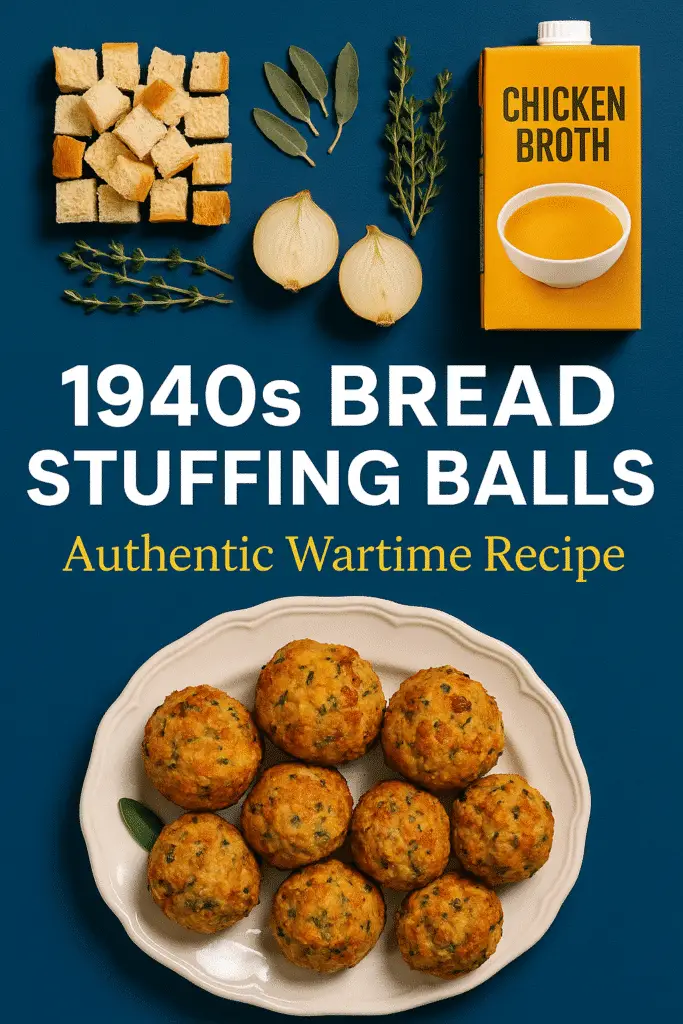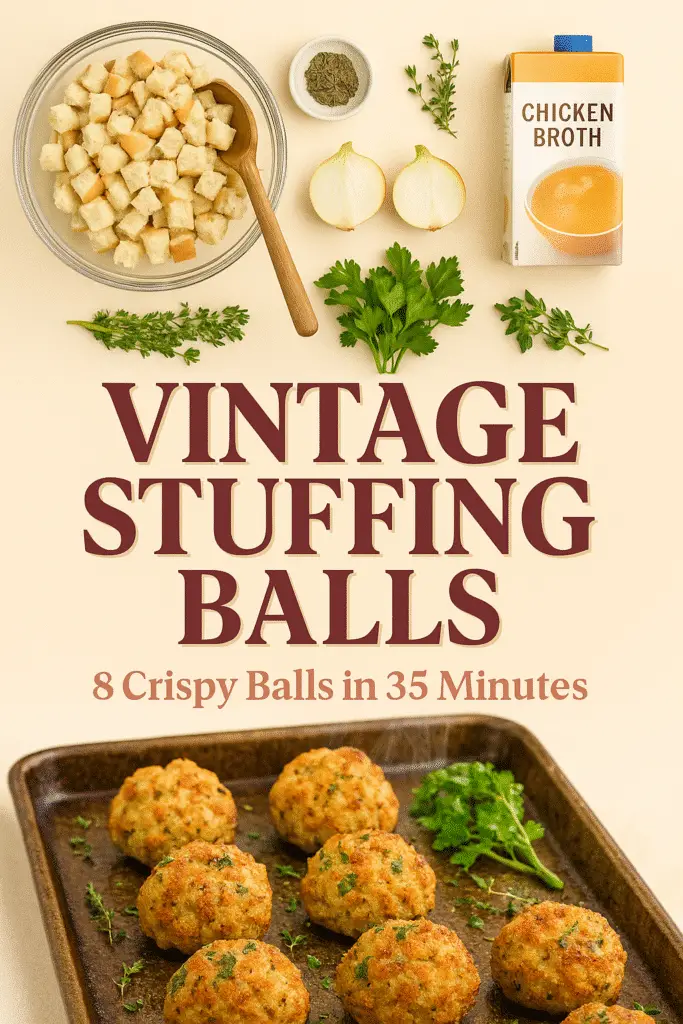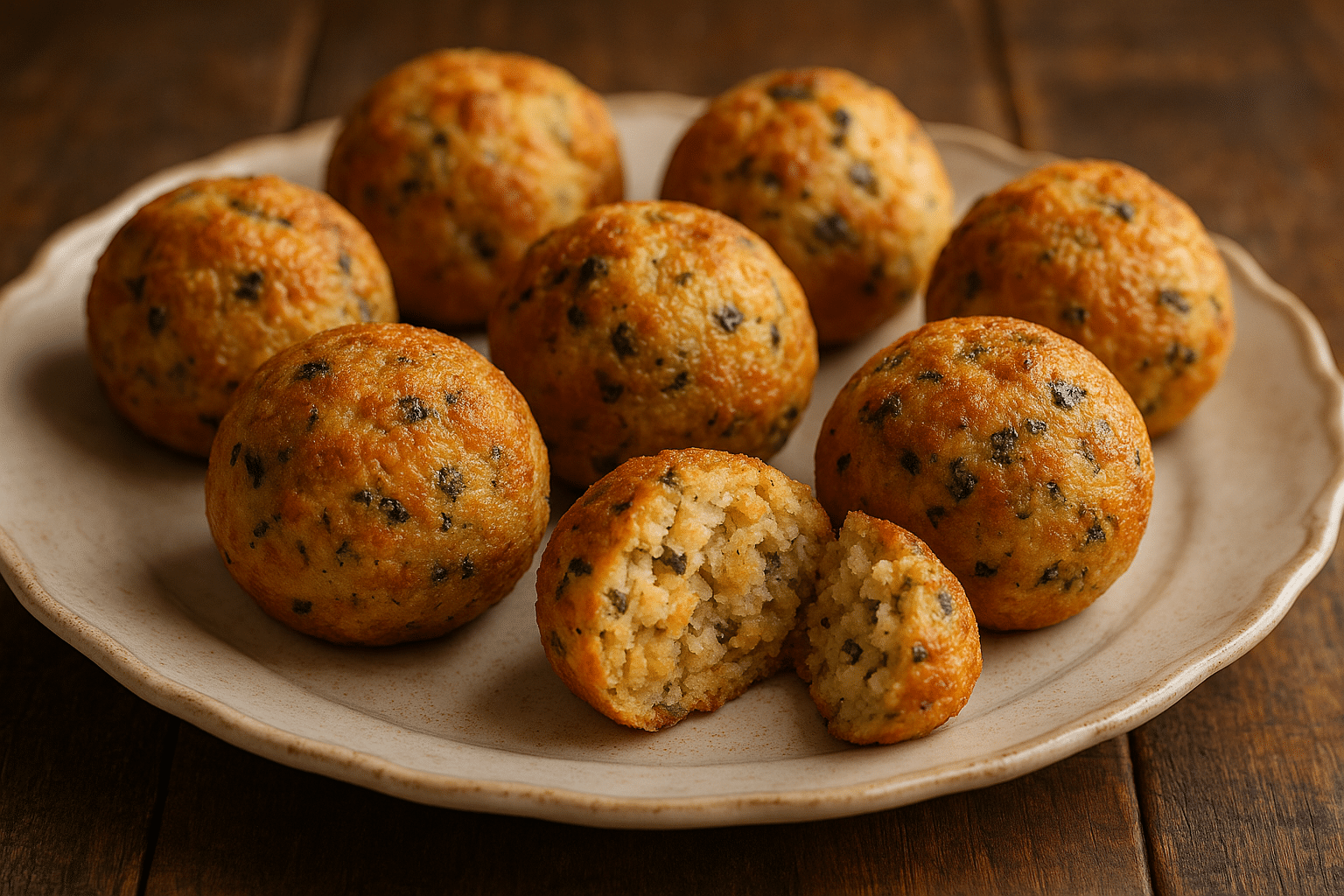During World War II, kitchens across America became creative hubs. The 1940s bread stuffing balls recipe showed how home cooks adapted to hard times. They made tasty dishes from simple ingredients.
The old-fashioned bread stuffing method was more than cooking. It was about survival and finding new ways to use what was available. Stale bread, often thrown away now, was a key ingredient for hearty meals that fed many.
Learning about the 1940s bread stuffing balls recipe connects us to a special time in American cooking history. These stuffing balls are more than a side dish. They stand for creativity, adaptability, and the strong spirit of home cooks in tough times.
Key Takeaways
- Wartime rationing sparked incredible kitchen creativity
- Stale bread became a valuable cooking ingredient
- 1940s recipes showcase resourceful cooking techniques
- Stuffing balls represent cultural culinary resilience
- Simple ingredients can create delicious, meaningful meals
The Charm of Vintage Cooking
Exploring wartime bread stuffing is like opening a treasured family cookbook. The 1940s kitchen was a place of creativity and resourcefulness. Every ingredient counted, and nothing was wasted. Retro holiday stuffing is more than a recipe; it’s a culinary time capsule that tells a story of resilience and innovation.
Why Choose a 1940s Recipe
Nostalgic Thanksgiving stuffing brings us back to a simpler time of cooking. During World War II, home cooks became masters of transformation. They turned humble ingredients into delicious meals that celebrated both flavor and frugality. The recipes from this era showcase incredible resourcefulness, deep respect for ingredients, and waste-free cooking techniques.
Nostalgic Ingredients
The magic of vintage stuffing lies in its simplicity. Stale bread became the star, transformed into a delectable dish. Herbs like sage and thyme, often grown in backyard gardens, added depth and aroma. Chicken drippings, bacon grease, and leftover roast fat were prized for their rich, complex flavors.

Simple Kitchen Tools
Unlike today’s gadget-filled kitchens, 1940s cooks relied on basic tools. A mixing bowl, wooden spoon, and baking dish were all they needed to create memorable meals. This minimalist approach proves that delicious food doesn’t require expensive equipment – just skill, creativity, and love.
Preparing the Bread Mixture
Starting a historical bread stuffing recipe means understanding 1940s cooking basics. It’s about turning simple ingredients into something special. The bread mixture is key, needing careful prep and detail.
Selecting the Right Bread
Choosing the right bread is important for stuffing. For a true 1940s taste, use sturdy white bread or day-old sourdough. The bread’s texture is vital for tasty homemade stuffing balls.
Stale vs. Fresh Bread Debate
Stale bread is better for stuffing. It soaks up flavors well and holds the mixture together. Here’s how to prepare bread:
- Cut bread into 1/2-inch cubes
- Spread cubes on a baking sheet
- Let air-dry for 24 hours
- Or toast lightly in a low-temperature oven
Dealing with Bread Crusts
Should you keep bread crusts? Yes, they add a nice texture. Trim off hard edges, but keep some crusts.
Seasoning the Mixture
Seasoning is what makes a bread stuffing special. Use classic herbs to bring 1940s cooking to life:
| Herb | Quantity | Flavor Profile |
|---|---|---|
| Dried Sage | 1 teaspoon | Earthy, warm |
| Thyme | 1/2 teaspoon | Slightly minty |
| Parsley | 2 tablespoons | Fresh, bright |
Mix these herbs into your bread mixture. This ensures flavors are evenly spread for authentic homemade stuffing balls.

Shaping and Baking the Stuffing Balls
Making classic stuffing balls is an art that needs precision and care. It’s a skill that was mastered in 1940s kitchens. I’ll show you how to make these bread stuffing balls using a traditional recipe. It will bring a touch of nostalgia to your meals.
Portioning the Mixture
It’s important to make the stuffing balls the same size. Use a standard ice cream scoop or measuring cup for this. Aim for balls that are about 2 inches in diameter. This size ensures they cook evenly and look great on your plate.
- Use a 1/4 cup measuring tool for consistent sizing
- Gently pack the mixture to maintain shape
- Leave slight space between balls on the baking sheet
Techniques for Shaping
Shaping the stuffing balls needs a gentle touch. Wet your hands a bit with warm water to stop the mixture from sticking. Roll the mixture between your palms to make smooth, compact balls. These will stay together while baking.
- Moisten hands with water
- Scoop mixture
- Roll between palms
- Place on prepared baking sheet
Baking Tips for Perfect Texture
The secret to perfect 1940s-style stuffing balls is in the baking. Preheat your oven to 375°F (190°C). Bake for 25-35 minutes, turning once halfway to ensure even browning. Look for a golden-brown outside and a moist inside.
Pro tip: Cover with foil for the first 15 minutes to prevent excessive browning. Then, uncover to get a crispy outside. This captures the essence of classic stuffing balls.
Serving Suggestions and Storage
My vintage stuffing balls can make any meal special. They go great with classic roast chicken or Thanksgiving turkey. Serve them as a side dish for a touch of 1940s charm.
Storing these stuffing balls right is important. Put them in an airtight container and refrigerate within two hours. They stay good for three to four days, perfect for meal prep or leftovers. Remember, keep them away from gravy or sauce to keep them crispy.
To reheat, use the oven for the best results. Place them on a baking sheet, cover with foil, and warm at 350°F for 10-15 minutes. If you’re short on time, the microwave works too. Just be careful not to overheat, which can make them soggy.
Follow these tips to make your old-fashioned bread stuffing a memorable dish. These stuffing balls are more than a side. They connect us to cooking traditions of the past.
FAQ
What makes 1940s bread stuffing balls different from modern stuffing recipes?
1940s bread stuffing balls stand out because they were made during wartime. They used simple ingredients like stale bread, onions, and herbs. This recipe shows how people cooked with what they had, making the most of flavor with little.
Can I use fresh bread instead of stale bread for these stuffing balls?
You can use fresh bread, but stale or day-old is better. Stale bread soaks up flavors better and gives a true texture. If you only have fresh bread, dry it out or lightly toast it.
How do I know when the stuffing balls are perfectly cooked?
They’re done when they’re golden brown and firm. The inside should be about 165°F (74°C). They should have a crispy outside and a soft inside, just like the old days.
Are these stuffing balls suitable for vegetarians?
Yes, vegetarians can enjoy these stuffing balls. Just use vegetable broth instead of meat broth and make sure your bread is vegetarian. The recipe focuses on bread, herbs, and veggies, making it great for many diets.
How long can I store leftover stuffing balls?
Store them in an airtight container in the fridge for 3-4 days. To reheat, bake at 350°F (175°C) for 10-15 minutes. This will make them crispy again and keep them tasty.
What herbs are traditionally used in 1940s stuffing balls?
Traditional herbs include sage, thyme, and parsley. These were often grown at home and added a rich flavor to the stuffing balls.
Can I freeze stuffing balls for later use?
Yes, you can freeze them! Freeze them on a baking sheet, then bag them. They’ll last up to a month. Thaw in the fridge and reheat in the oven until crispy.

1940s Bread Stuffing Balls: Authentic Wartime Recipe for 8 Crispy Balls
- Total Time: 1 hour 20 minutes
- Yield: 8 stuffing balls 1x
Description
Authentic 1940s bread stuffing balls made with stale bread, sage, and thyme. These crispy vintage stuffing balls capture the resourceful spirit of wartime cooking with simple ingredients and traditional techniques.
Ingredients
6 cups stale white bread, cut into 1/2-inch cubes
1 large yellow onion, finely diced
1 teaspoon dried sage
1/2 teaspoon dried thyme
2 tablespoons fresh parsley, chopped
2 cups chicken broth
3 tablespoons butter
1/2 teaspoon salt
1/4 teaspoon black pepper
1 large egg, beaten
Instructions
1. Preheat oven to 375°F (190°C) and line a baking sheet with parchment paper.
2. Cut bread into 1/2-inch cubes and let air-dry for 24 hours or toast lightly in low oven.
3. In a large skillet, melt butter over medium heat and sauté diced onion until translucent, about 5 minutes.
4. In a large mixing bowl, combine bread cubes, sautéed onions, sage, thyme, parsley, salt, and pepper.
5. Gradually add chicken broth while mixing until mixture holds together but isn’t soggy.
6. Stir in beaten egg to bind the mixture.
7. Using wet hands or ice cream scoop, form mixture into 8 balls, about 2 inches in diameter.
8. Place stuffing balls on prepared baking sheet, leaving space between each ball.
9. Cover with foil and bake for 15 minutes, then uncover and bake 15-20 minutes more until golden brown.
10. Let cool for 5 minutes before serving.
Notes
For best results, use day-old or stale bread as it absorbs flavors better.
Wet your hands when shaping to prevent mixture from sticking.
Store leftovers in refrigerator for 3-4 days.
Reheat in 350°F oven for 10-15 minutes to restore crispiness.
Can be frozen for up to 1 month – thaw before reheating.
- Prep Time: 45 minutes
- Cook Time: 35 minutes
- Category: Side Dish
- Method: Baking
- Cuisine: American
Nutrition
- Serving Size: 1 stuffing ball
- Calories: 145
- Sugar: 3g
- Sodium: 285mg
- Fat: 4g
- Saturated Fat: 2g
- Unsaturated Fat: 2g
- Trans Fat: 0g
- Carbohydrates: 22g
- Fiber: 2g
- Protein: 5g
- Cholesterol: 35mg

